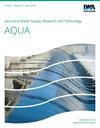Spatial and seasonal variations in nutrient load and trophic status of Ganga and Yamuna rivers in Uttar Pradesh, India
IF 4.3
Q2 Environmental Science
引用次数: 0
Abstract
Nutrient loading in aquatic systems from anthropogenic sources is a worldwide concern. The Ganga is the most important river in India, but pollution is currently severely threatening its biodiversity and long-term environmental viability. Water samples were taken from 36 locations along the length of the Ganga and Yamuna rivers in Uttar Pradesh and analysed for nutrient concentration to evaluate the nutrient load, eutrophication danger, and river trophic status. The average concentration of NO3-N, PO4-P, NH4-N, and SiO2-Si exceeded the values in unpolluted rivers, indicating the contribution of anthropogenic sources. The concentration of NO3-N and NH4-N showed significant spatial variation, and PO4-P showed significant seasonal variation in the study area. The DIN/DIP ratio in the study area exceeded 16:1, indicating a phosphate-limiting condition for phytoplankton development. The DSi/DIN value showed a declining trend in the downstream region of both rivers with average values <1, indicating nitrate pollution leading to eutrophic conditions. The Indicator for Coastal Eutrophication Potential (ICEP) showed a positive value, indicating that the Ganga and Yamuna rivers in Uttar Pradesh were eutrophic due to nitrogen pollution. Trophic State Index (TSI) values indicated that super-eutrophic conditions existed in the Ganga River (65.62) and hypereutrophic conditions existed in the Yamuna River (75.55) in Uttar Pradesh.印度北方邦恒河和亚穆纳河养分负荷和营养状况的空间和季节变化
水生系统中人为来源的营养负荷是一个全世界关注的问题。恒河是印度最重要的河流,但污染目前正严重威胁着其生物多样性和长期环境生存能力。从北方邦恒河和亚穆纳河沿线的36个地点采集水样,分析营养物浓度,以评估营养物负荷、富营养化危险和河流营养状况。NO3-N、PO4-P、NH4-N和SiO2-Si的平均浓度均超过未污染河流,表明有人为源的贡献。研究区NO3-N和NH4-N浓度存在显著的空间差异,PO4-P浓度存在显著的季节差异。研究区DIN/DIP比值超过16:1,表明存在浮游植物发育的限磷条件。两河下游DSi/DIN值均呈下降趋势,平均值<1,表明硝酸盐污染导致富营养化。沿海富营养化潜力指数(ICEP)呈正值,表明恒河和亚穆纳河因氮污染而富营养化。营养状态指数(TSI)值表明,北方邦恒河(65.62)和亚穆纳河(75.55)存在超富营养化状态。
本文章由计算机程序翻译,如有差异,请以英文原文为准。
求助全文
约1分钟内获得全文
求助全文
来源期刊
CiteScore
4.70
自引率
0.00%
发文量
74
审稿时长
4.5 months
期刊介绍:
Journal of Water Supply: Research and Technology - Aqua publishes peer-reviewed scientific & technical, review, and practical/ operational papers dealing with research and development in water supply technology and management, including economics, training and public relations on a national and international level.

 求助内容:
求助内容: 应助结果提醒方式:
应助结果提醒方式:


